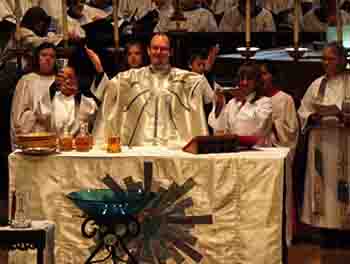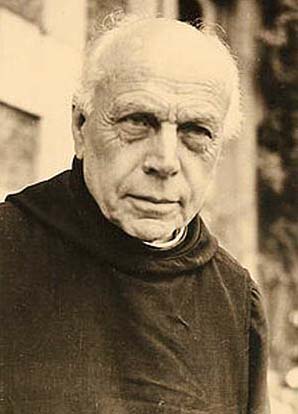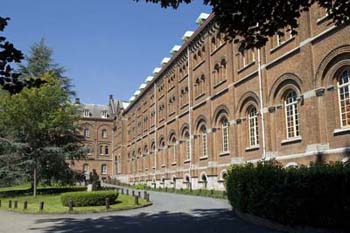Traditionalist Issues
 |
 |
 |
 |
 |
 |
 |
Dialogue Mass - III
The Start of the New Liturgical Reform
In the previous article, examples were given to show that the intended official Italian version of Pius X’s motu proprio Tra le Sollecitudini (TLS) is, in some respects, a new text with a spirit of novelty that does not exist in the Latin version. Anyone who pauses to reflect on the implications of this anomaly can see what is amiss.
 In any translation, an exact conformity is required to carry over (which is the meaning of “translate”) the same ideas from one language to another. But in the case of TLS (and its further translation into other vernacular languages), some interested party has obviously had a powerful influence on the choice of phrases that promote the agenda of the reformers.
In any translation, an exact conformity is required to carry over (which is the meaning of “translate”) the same ideas from one language to another. But in the case of TLS (and its further translation into other vernacular languages), some interested party has obviously had a powerful influence on the choice of phrases that promote the agenda of the reformers.
This independent spirit is strikingly evident at those key points where TLS (and other vernacular versions) diverge from the Latin text. These can be summed up as follows:
Although some may argue that “active participation” by the laity could be interpreted differently, nevertheless the expression was driven by its own internal logic to focus attention on the people and give them an inflated sense of their own activities in the liturgy. The inevitable result – though few realized it at the time – was that it would be used to justify the destruction of centuries of Catholic liturgy and the creation of a radically new Mass in which the “People of God” are regarded as the celebrants on an equal footing with the priests.
The role of Dom Lambert Beauduin
After the fateful and entirely inappropriate expression “active participation” appeared out of the blue in 1903, it got a muted reception. Few people – unless they had a goal to score – knew what to make of it or what to do with it.
The first person to pick up the ball and run with it was the Benedictine monk, Dom Lambert Beauduin (1873-1960) of the Monastery of Mont César in Belgium. His goal was both ecumenical and secular: to promote the “universal priesthood of all believers” through “participatory” liturgy and unite them in a common programme of social reform and pan-Christian “unity.”
It was not for nothing that Beauduin is regarded as the founder of the New Liturgical Movement and a prophet of the “pastoral” Vatican II. He actually anticipated by half a century the most important progressivist advances of Vatican II in the key areas of liturgy, ecumenism and ecclesiology.
The barbarian in the citadel
From the beginning of his clerical career, Beauduin revealed a deep alienation from the values and spirituality of traditional Catholicism. He pursued a campaign of increasing hostility against Catholic devotions. Even in his seminary days, he rebelled against the regime of spirituality and the necessity to follow the strict rubrics of the Mass. (1)
 It is unsurprising that he showed no interest in the Missal: it was, for him, “a closed and sealed book” (un livre fermé et scellé). He considered the liturgical books in general to be no more than “mumbo jumbo, incantations and magical formulae” (des grimoires). He also admitted that he had never recited his Breviary with the least devotion or interest. (2)
It is unsurprising that he showed no interest in the Missal: it was, for him, “a closed and sealed book” (un livre fermé et scellé). He considered the liturgical books in general to be no more than “mumbo jumbo, incantations and magical formulae” (des grimoires). He also admitted that he had never recited his Breviary with the least devotion or interest. (2)
It is clear that, as a priest, Beauduin had not received – because he rejected – a proper Catholic formation. Instead, he spent his days in the seminary at Liège under the tutelage of the Professor of Moral Theology, Fr. Antoine Pottier, who, as the local leader of the Christian Democrat Movement, was a political firebrand, kindling workers’ demonstrations and strikes.
In fact, Fr. Pottier’s militant pro-worker activities, coupled with his antagonism against employers in Liège, caused Leo XIII to intervene personally in 1895 and require him to give up his social and political activism for the sake of peace and harmony. (3)
Soon after his ordination in 1897, Beauduin joined the Congregation des Aumôniers du Travail, a society of worker-priests that had been established by the Bishop of Liège, Mgr. Victor Doutreloux. He then spent 7 years living among the workers in the footsteps of Fr. Pottier after the latter’s enforced retirement from political agitation.
The experience radicalized his outlook. Just as he saw society in terms of a conflict between the rich and the poor, industrialists and workers, he saw a counterpart in the constitution of the Church. He argued that active participation in the liturgy would unite the faithful for social change and for the “emancipation” of the laity from “domination” by the clergy. At this point the Liturgical Movement was effectively turned into a platform for Marxist propaganda within the Church.
 Beauduin’s decision to become a monk of the Monastery of Mont César in 1906 was critical for the development of the Liturgical Movement. Once inside, he began to pull up the drawbridge against the “unacceptable” face of traditional Catholicism.
Beauduin’s decision to become a monk of the Monastery of Mont César in 1906 was critical for the development of the Liturgical Movement. Once inside, he began to pull up the drawbridge against the “unacceptable” face of traditional Catholicism.
Mont César was to become the nexus of strategic planning for various projects: promoting “active participation” among the laity, adapting the liturgy to contemporary needs, linking it to social activism, reorienting monastic life (in Beauduin’s opinion, “too closed in upon itself”) towards the world outside the cloister, and fostering ecumenism among religions without seeking conversion to Catholicism.
Beauduin’s decision to enter Mont César was not without its material advantages: he was able to exploit the Monastery’s financial resources to launch the Liturgical Movement in a way that was not possible for a simple parish priest. He had at his disposal a willing cohort of monks to help prepare his publications, which he disseminated by means of the Monastery’s printing press, and he hosted liturgical weeks and retreats in the Monastery’s accommodation.
Continued

Posted April 4, 2014
Active participation in the Offertory of a Mass said at All Saints Church in Pasadena, California
This independent spirit is strikingly evident at those key points where TLS (and other vernacular versions) diverge from the Latin text. These can be summed up as follows:
- A call to adopt the liturgical practices of the early Church in the matter of congregational singing (“as was the case in ancient times”);
- The suggestion that vocalization by the laity is the litmus test of their true participation in the liturgy;
- A shift in emphasis towards the “common priesthood of the baptized” and away from the sacramental priesthood of the priest who alone offers the Mass in an official capacity for the living and the dead;
- An implied criticism of silent participation by the laity who may be saying private prayers during Mass.
Although some may argue that “active participation” by the laity could be interpreted differently, nevertheless the expression was driven by its own internal logic to focus attention on the people and give them an inflated sense of their own activities in the liturgy. The inevitable result – though few realized it at the time – was that it would be used to justify the destruction of centuries of Catholic liturgy and the creation of a radically new Mass in which the “People of God” are regarded as the celebrants on an equal footing with the priests.
The role of Dom Lambert Beauduin
After the fateful and entirely inappropriate expression “active participation” appeared out of the blue in 1903, it got a muted reception. Few people – unless they had a goal to score – knew what to make of it or what to do with it.
The first person to pick up the ball and run with it was the Benedictine monk, Dom Lambert Beauduin (1873-1960) of the Monastery of Mont César in Belgium. His goal was both ecumenical and secular: to promote the “universal priesthood of all believers” through “participatory” liturgy and unite them in a common programme of social reform and pan-Christian “unity.”
It was not for nothing that Beauduin is regarded as the founder of the New Liturgical Movement and a prophet of the “pastoral” Vatican II. He actually anticipated by half a century the most important progressivist advances of Vatican II in the key areas of liturgy, ecumenism and ecclesiology.
The barbarian in the citadel
From the beginning of his clerical career, Beauduin revealed a deep alienation from the values and spirituality of traditional Catholicism. He pursued a campaign of increasing hostility against Catholic devotions. Even in his seminary days, he rebelled against the regime of spirituality and the necessity to follow the strict rubrics of the Mass. (1)

Beauduin, today recognized as the founder of the New Liturgical Reform
It is clear that, as a priest, Beauduin had not received – because he rejected – a proper Catholic formation. Instead, he spent his days in the seminary at Liège under the tutelage of the Professor of Moral Theology, Fr. Antoine Pottier, who, as the local leader of the Christian Democrat Movement, was a political firebrand, kindling workers’ demonstrations and strikes.
In fact, Fr. Pottier’s militant pro-worker activities, coupled with his antagonism against employers in Liège, caused Leo XIII to intervene personally in 1895 and require him to give up his social and political activism for the sake of peace and harmony. (3)
Soon after his ordination in 1897, Beauduin joined the Congregation des Aumôniers du Travail, a society of worker-priests that had been established by the Bishop of Liège, Mgr. Victor Doutreloux. He then spent 7 years living among the workers in the footsteps of Fr. Pottier after the latter’s enforced retirement from political agitation.
The experience radicalized his outlook. Just as he saw society in terms of a conflict between the rich and the poor, industrialists and workers, he saw a counterpart in the constitution of the Church. He argued that active participation in the liturgy would unite the faithful for social change and for the “emancipation” of the laity from “domination” by the clergy. At this point the Liturgical Movement was effectively turned into a platform for Marxist propaganda within the Church.

Under Beauduin, the Abbey of Mont César, above, became the first hotbed of liturgical reform
Mont César was to become the nexus of strategic planning for various projects: promoting “active participation” among the laity, adapting the liturgy to contemporary needs, linking it to social activism, reorienting monastic life (in Beauduin’s opinion, “too closed in upon itself”) towards the world outside the cloister, and fostering ecumenism among religions without seeking conversion to Catholicism.
Beauduin’s decision to enter Mont César was not without its material advantages: he was able to exploit the Monastery’s financial resources to launch the Liturgical Movement in a way that was not possible for a simple parish priest. He had at his disposal a willing cohort of monks to help prepare his publications, which he disseminated by means of the Monastery’s printing press, and he hosted liturgical weeks and retreats in the Monastery’s accommodation.
Continued
- These he dismissed derisively as a “series of minutely detailed and arbitrary rules imposed, it would seem, to try the patience of those who study them and put them into practice” (série de prescriptions minutieuses et arbitraries, imposées, croirait-on, pour exercer la patience de ceux qui les étudient et les accomplissent). Quoted in Jacques Mortiau, Raymond Loonbeek and Enzo Bianchi, Don Lambert Beauduin Visionnaire et Précurseur: un moine au coeur libre, Cerf, 2005, pp. 22-23.
- Ibid., p. 20.
- Jean-Louis Jadoulle, “Question sociale et politique pontificale. L'itinéraire d'un démocrate chrétien: Antoine Pottier (1849-1923)’,” Revue belge de Philologie et d'Histoire, 1991, vol. 69, n. 69-2, p. 318. It is also clear that Fr. Pottier adhered to the Socialist view that workers had a right to an equal share in the profits made by their employers (ibid., pp. 310-311, and that wages should be set by the State.

Posted April 4, 2014
______________________
______________________
 Volume I |
 Volume II |
 Volume III |
 Volume IV |
 Volume V |
 Volume VI |
 Volume VII |
 Volume VIII |
 Volume IX |
 Volume X |
 Volume XI |
 Special Edition |


